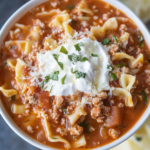Lasagna Soup brings all the hearty, comforting flavors of classic lasagna into a single, easy-to-make bowl. This one-pot meal combines rich tomato broth, tender pasta, seasoned beef, and creamy cheese for an Italian-inspired dish perfect for weeknights. Unlike traditional lasagna, which requires layering, baking, and careful assembly, Lasagna Soup simplifies the process without sacrificing any of the bold flavors you expect from a lasagna dish.
This recipe appeals to both home cooks looking for a comforting meal and busy families who need dinner on the table fast. Whether you crave the familiar taste of lasagna or need a crowd-pleasing option for dinner, Lasagna Soup delivers. It’s adaptable to different dietary needs, allowing you to swap the beef for ground turkey, Italian sausage, or even plant-based crumbles for a vegetarian twist. The soup also stores well, making it ideal for meal prep and leftovers.
Readers will love Lasagna Soup because it combines simplicity, flavor, and versatility into one pot. It’s a wonderful way to enjoy the flavors of traditional lasagna without spending hours in the kitchen. Plus, the recipe works for all seasons — it’s warming and hearty in the winter but light enough for cooler summer evenings.

Preparation Phase & Tools to Use
Like any well-executed recipe, Lasagna Soup benefits from a bit of preparation before cooking begins. Start by chopping the onions, mincing the garlic, and gathering all necessary ingredients. Pre-measuring the pasta, broth, and seasonings ensures smooth, uninterrupted cooking.
Since this is a one-pot recipe, you only need a handful of basic tools, making cleanup easy. However, each tool plays an important role in the success of your Lasagna Soup.
Essential Tools and Equipment
- Large soup pot or Dutch oven (at least 4.5 quarts)
- Sharp knife and cutting board for chopping
- Measuring cups and spoons for precise ingredient amounts
- Wooden spoon for stirring pasta and meat without scratching the pot
- Cheese grater for fresh mozzarella and Parmesan
- Optional: Pressure cooker for quicker cooking
Using a high-quality soup pot ensures even heat distribution, preventing pasta from sticking or overcooking in certain spots. A wooden spoon is ideal for stirring the soup gently while breaking up ground beef into smaller crumbles.
Preparation Tips
- Set all ingredients near your stovetop before starting to cook.
- Pre-measure seasonings into a small bowl to save time.
- Use freshly grated cheese for the best melt and texture.
- Keep a bowl of hot water nearby to adjust the broth’s consistency if the pasta absorbs too much liquid.
Ingredient List
Meat & Aromatics
- 1-2 tablespoons olive oil
- 1 pound ground beef
- 1 large onion, diced
- 4 cloves garlic, minced
Tomato Components
- 1 (15-ounce) can diced tomatoes (with juice)
- 1 (15-ounce) can tomato sauce or tomato puree
- 3 ounces tomato paste (about ¼ cup)
Liquid & Seasonings
- 4 cups chicken broth
- 1-2 cups water (adjust as needed)
- 1 tablespoon Italian seasoning
- 1 teaspoon sea salt
- Black pepper, to taste
Pasta
- 8 ounces bowtie pasta (uncooked)
Toppings
- ½ cup ricotta cheese
- 2 ounces mozzarella cheese, shredded (about ½ cup)
- ¼ cup Parmesan cheese, grated
- ¼ cup fresh parsley, chopped
Step-by-Step Directions
Stovetop Method
- Heat olive oil in a large soup pot over medium-high heat.
- Add ground beef, diced onion, and minced garlic. Sauté until the beef browns and the onion softens. Drain excess fat if necessary.
- Stir in the diced tomatoes (with juice), tomato sauce, tomato paste, chicken broth, Italian seasoning, salt, and pepper.
- Add the uncooked pasta directly into the pot.
- Increase the heat to bring the mixture to a boil, then reduce to medium.
- Simmer uncovered for 10 to 15 minutes, stirring frequently to prevent pasta from sticking to the pot’s bottom.
- Check the pasta for doneness. Add extra water or broth if the soup thickens too much.
- Taste and adjust seasonings if needed.
- Serve hot, with ricotta, mozzarella, Parmesan, and parsley either stirred into the pot or sprinkled over individual bowls.
Pressure Cooker/Instant Pot Method
- Set pressure cooker to sauté mode and heat the olive oil.
- Brown the beef with onions and garlic. Drain excess fat and deglaze the pot with a splash of broth.
- Add tomatoes, tomato sauce, tomato paste, broth, Italian seasoning, salt, pepper, and pasta.
- Secure the lid and set to high pressure for 1 minute.
- Perform a quick release for al dente pasta or allow a 10-minute natural release for softer pasta.
- Stir the soup, check the consistency, and add water if needed.
- Serve with toppings as desired.
Serving Suggestions
Lasagna Soup is not just a comforting one-pot meal — it’s also highly customizable when it comes to serving. One of the best parts of this recipe is the way each bowl can be tailored to personal taste. Some people prefer their Lasagna Soup extra cheesy, while others like it with a sprinkle of fresh herbs for added brightness.
You can either stir the ricotta, mozzarella, and Parmesan directly into the pot before serving or allow each guest to customize their own bowl. Offering toppings on the side, including chopped parsley, red pepper flakes, or even a drizzle of olive oil, creates a fun, interactive dining experience.
To elevate presentation, serve Lasagna Soup in wide bowls with a generous spoonful of creamy ricotta right in the center. The heat from the soup will gently melt the cheese, creating that signature lasagna-like texture. For a rustic touch, sprinkle freshly grated Parmesan and a few cracks of black pepper right before serving.
If you’re hosting guests, consider adding a light drizzle of balsamic glaze across the top for a gourmet twist. While Lasagna Soup is already filling on its own, pairing it with a complementary side dish can turn the meal into a complete Italian-inspired feast.
Common Mistakes & How to Perfect Lasagna Soup
Even though Lasagna Soup is a relatively simple dish, a few common mistakes can affect the final result. Knowing these pitfalls and how to avoid them helps ensure your soup comes out perfectly every time.
Overcooking the Pasta
One of the most frequent errors is letting the pasta cook too long, especially if the soup sits on the stove after the heat is off. To avoid mushy pasta, cook it just until al dente. If you expect leftovers, consider cooking the pasta separately and adding it to each bowl when reheating.
Using the Wrong Pasta
While lasagna noodles can be broken into pieces for this recipe, they tend to fall apart after sitting in the broth. Sturdier shapes, like bowtie, rigatoni, or rotini, hold their shape better. These options also cling to the broth, cheese, and meat more effectively.
Skipping the Seasoning Adjustments
Since pasta absorbs a significant amount of flavor from the broth, the seasoning level can change after simmering. Always taste the soup before serving, adjusting salt, pepper, or even adding a splash of lemon juice or balsamic vinegar for brightness.
Failing to Drain Excess Fat
After browning the beef, it’s important to drain any excess fat to avoid a greasy broth. This step ensures the tomato broth stays rich and balanced without becoming too heavy.
Adding All the Cheese Too Early
Cheese adds wonderful creaminess and flavor, but if you add it too early, it can separate or turn stringy. Save the ricotta, mozzarella, and Parmesan for garnishing individual bowls or stirring in just before serving to maintain the perfect texture.
Forgetting to Stir Frequently
As the pasta simmers, it can sink to the bottom and stick to the pot. Frequent stirring helps prevent clumps and ensures even cooking.
Using Low-Quality Tomatoes
Since tomatoes form the flavor base of Lasagna Soup, using high-quality canned tomatoes or even San Marzano tomatoes can make a noticeable difference. Cheaper options may taste overly acidic or watery, throwing off the balance of the broth.
Ignoring Consistency Adjustments
Pasta naturally absorbs liquid as it sits, so what starts as a soup may thicken into a stew. Keeping extra broth or hot water on hand allows you to adjust the consistency at any time. Stirring in extra liquid just before serving helps maintain the ideal texture.
Side Dish Recommendations
While Lasagna Soup stands well on its own, serving it alongside a well-chosen side dish enhances the meal’s overall appeal. Below are some ideal pairings that balance flavors and textures.
1. Garlic Bread
The classic companion to any Italian soup, garlic bread offers buttery crunch that complements the rich tomato broth.
2. Caesar Salad
A crisp Caesar salad with romaine, Parmesan, and a tangy dressing adds freshness and crunch to the meal.
3. Antipasto Platter
Serve an assortment of cured meats, cheeses, olives, and marinated vegetables for a casual appetizer that pairs well with Lasagna Soup.
4. Roasted Vegetables
A simple tray of roasted zucchini, bell peppers, and mushrooms adds lightness and an earthy contrast to the hearty soup.
5. Caprese Salad
Fresh mozzarella, ripe tomatoes, and basil drizzled with balsamic glaze offer a bright, refreshing contrast to the savory soup.
6. Bruschetta
Crisp bread topped with diced tomatoes, garlic, and basil creates a light, flavorful starter.
7. Stuffed Mushrooms
These bite-sized mushrooms, filled with cheese, herbs, and breadcrumbs, provide a tasty appetizer that echoes the flavors in the soup.
8. Focaccia Bread
Soft, herby focaccia is ideal for dipping into the rich tomato broth, soaking up every bit of flavor.
Recipe Tips & Creative Variations
One of the best things about Lasagna Soup is how easily it adapts to personal tastes, dietary preferences, and ingredient availability. Whether you want to make it healthier, vegetarian, or extra indulgent, the flexibility of this recipe ensures it works for everyone.
Swap the Protein
While ground beef is the traditional choice for Lasagna Soup, it’s not the only option. Ground turkey or chicken offers a leaner alternative without losing flavor. For a more robust taste, Italian sausage brings extra seasoning and richness. If you prefer a vegetarian version, lentils, mushrooms, or plant-based ground crumbles work well.
Adjust the Cheese
Traditional lasagna features ricotta, mozzarella, and Parmesan, but you can easily modify the cheese blend to suit your preferences. Whole milk ricotta melts into the broth for creamy texture, while fresh mozzarella adds stretchiness. Pecorino Romano can replace Parmesan for a sharper bite. If you want a dairy-free version, skip the cheese entirely or use vegan alternatives.
Flavor Boosters
A splash of balsamic vinegar or red wine in the broth enhances the tomato base with subtle acidity and depth. For a touch of heat, red pepper flakes or a dash of hot sauce works well. Fresh basil, oregano, or thyme can replace or enhance the Italian seasoning blend, offering fresher herbaceous notes.
Pasta Options
Bowtie pasta works well because of its sturdy shape, but other varieties shine too. Rigatoni, rotini, or even small shells hold the broth and cheese beautifully. If you need a gluten-free version, opt for gluten-free pasta, but cook it separately to prevent over-softening.
Storage and Reheating Instructions
Storing Lasagna Soup
Proper storage preserves the flavor and texture of Lasagna Soup, ensuring it tastes just as good the next day. After the soup cools completely, transfer it to airtight containers. Refrigerate for up to 5 days.
If you anticipate storing leftovers longer, freezing works well. Store in freezer-safe containers, leaving room for expansion. For the best quality, freeze for up to 3 months. To avoid mushy pasta, some cooks prefer freezing the broth and meat mixture separately and adding freshly cooked pasta when reheating.
Reheating Lasagna Soup
When reheating, you’ll likely need to adjust the consistency. Pasta continues to absorb liquid during storage, thickening the broth. To restore the perfect soup-like texture, add extra broth or water when warming it up.
Stovetop reheating offers the most control. Heat the soup gently over medium heat, stirring occasionally and adjusting the liquid as needed. For faster reheating, the microwave works too — heat in short bursts, stirring between intervals.
Frequently Asked Questions (FAQs)
What is Lasagna Soup made of?
Lasagna Soup includes ground beef, onions, garlic, tomatoes, broth, pasta, and a blend of ricotta, mozzarella, and Parmesan cheese. These classic ingredients recreate the flavors of traditional lasagna in a quicker, one-pot format.
Can I make Lasagna Soup vegetarian?
Absolutely. Replace the ground beef with chopped mushrooms, lentils, or plant-based crumbles. Use vegetable broth instead of chicken broth for a fully vegetarian dish.
What pasta works best for Lasagna Soup?
Bowtie, rotini, rigatoni, or even small shells hold up well in soup. While you can break lasagna noodles into smaller pieces, they tend to soften too much after sitting in the broth.
Can I make Lasagna Soup in a slow cooker?
Yes. Brown the meat, onions, and garlic in a skillet before transferring them to the slow cooker. Add the broth, tomatoes, and seasonings, then cook on low for 6 to 8 hours. Stir in the pasta during the last 30 minutes to avoid overcooking.
How do I keep pasta from getting mushy in Lasagna Soup?
For the best texture, cook the pasta separately and add it to each bowl when serving. This also makes reheating easier since the pasta won’t continue to absorb liquid in storage.
What cheese works best in Lasagna Soup?
A combination of ricotta, mozzarella, and Parmesan creates the classic lasagna flavor. Ricotta adds creaminess, mozzarella melts beautifully, and Parmesan brings a salty, nutty finish.
Can I freeze Lasagna Soup?
Yes. For best results, freeze the soup without the pasta, then add fresh pasta after reheating. This preserves the best texture.
Is Lasagna Soup healthy?
The base recipe is hearty and filling, but you can lighten it up by using lean ground turkey, whole wheat pasta, low-sodium broth, and reduced-fat cheese. Adding spinach or kale boosts the nutritional value without affecting flavor.
Conclusion
Lasagna Soup combines the rich, comforting flavors of traditional lasagna with the ease of a one-pot meal. Whether you prepare it on the stovetop, in a pressure cooker, or even in a slow cooker, this versatile dish works for weeknight dinners, meal prep, or family gatherings. Its hearty tomato broth, tender pasta, and creamy cheese topping satisfy every craving for Italian comfort food without the hassle of layering and baking.
With so many customization options — from protein swaps to vegetarian adaptations — Lasagna Soup is a recipe you can make your own. Serve it with garlic bread, a fresh salad, or even an antipasto platter for a complete meal that’s as casual or elegant as you need it to be.
Try it once, and it’s sure to become a regular in your meal rotation. Whether you’re cooking for a crowd or making extra for leftovers, Lasagna Soup offers the perfect balance of flavor, simplicity, and comfort.
Lasagna Soup
Ingredients
- 1-2 tablespoons olive oil or preferred oil
- 1 pound ground beef
- 1 large onion diced
- 4 cloves garlic minced
- 1 15-ounce can diced tomatoes (do not drain)
- 1 15-ounce can tomato sauce or tomato puree
- 3 ounces tomato paste about ¼ cup
- 4 cups chicken broth
- 1-2 cups water or more as needed to adjust consistency
- 1 tablespoon Italian seasoning
- 1 teaspoon sea salt or more to taste
- Black pepper to taste
- 8 ounces bowtie pasta uncooked; see notes for substitutions
- Suggested Toppings
- ½ cup ricotta cheese
- 2 ounces mozzarella cheese shredded (about ½ cup)
- ¼ cup Parmesan cheese shaved, shredded, or grated
- ¼ cup fresh parsley chopped
Instructions
- Heat a 4.5-quart soup pot over medium-high heat. Add the olive oil and heat until shimmering.
- Add the ground beef, onions, and garlic. Sauté until the beef is cooked through, breaking it up and stirring as needed. Drain excess fat if necessary.
- Stir in the diced tomatoes (with juice), tomato sauce, tomato paste, chicken broth, Italian seasoning, salt, pepper, and uncooked pasta.
- Increase the heat to high and bring the soup to a boil.
- Reduce the heat to medium and simmer the soup for 10-15 minutes, stirring frequently to prevent the pasta from sticking together, until the pasta is cooked to your liking.
- Adjust the consistency of the soup by adding more water or broth, if needed.
- Serve with your desired toppings. You can either stir the ricotta, mozzarella, and Parmesan into the entire pot or offer them on the side for individual servings. Garnish with fresh parsley.
Storage Instructions
- Allow the soup to cool completely before storing in an airtight container. Refrigerate for up to 5 days.
- For freezing, transfer to a freezer-safe container and freeze for up to 90 days (longer if vacuum sealed).
- Reheating Instructions
- When reheating, add small amounts of water or broth to adjust the consistency, as the pasta will absorb liquid during storage.
Notes
If you don’t have canned tomato products, you can replace them with a 24-ounce jar of marinara sauce and 1 cup of water. Pressure Cooker Instructions Select “Sauté” mode and heat the olive oil in the pressure cooker. Add the ground beef, onions, and garlic; sauté until cooked through. Drain excess fat and deglaze the pot with a splash of broth. Press “Cancel.”
Stir in the diced tomatoes, tomato sauce, tomato paste, broth, Italian seasoning, salt, pepper, and pasta. Secure the lid and set the valve to “Sealing.” Pressure cook on high for 1 minute. For al dente pasta, do a quick release. For softer pasta, allow a natural release for 10 minutes before opening the lid. Stir and adjust the consistency with additional water or broth if needed. Serve with toppings as desired.




Leave a Comment